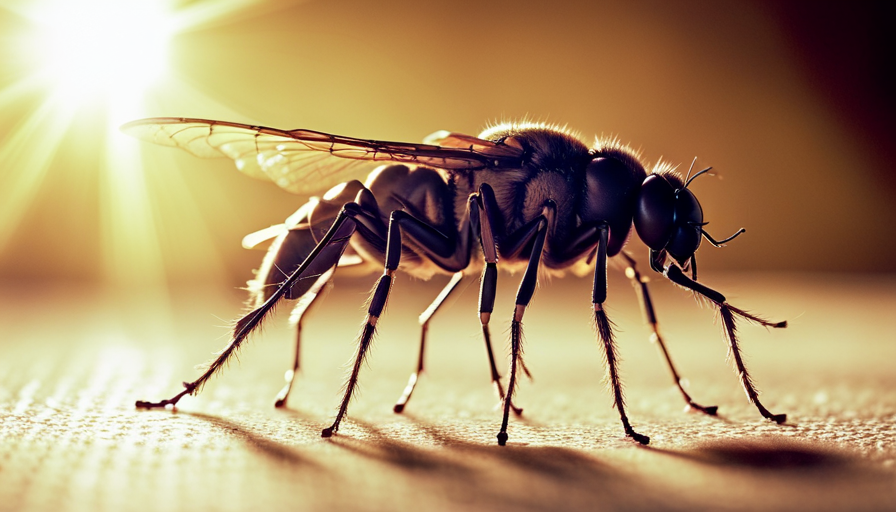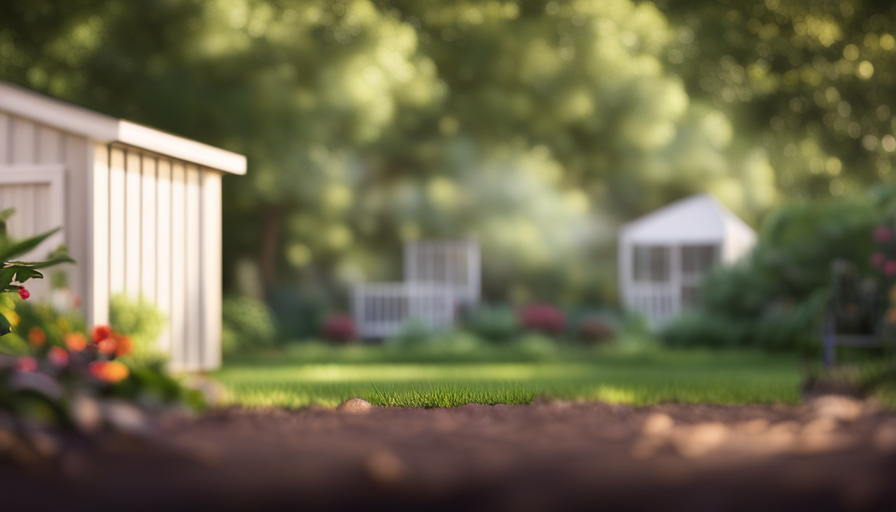Did you know that an average home can have over 100,000 small flies and gnats? These pesky bugs can be a major nuisance, buzzing around and disrupting your meals. But fret not, I am here to help you get rid of them once and for all.
In this article, I will provide you with a comprehensive guide on how to eliminate these tiny pests from your house.
First, it’s important to identify the source of the infestation. Gnats and tiny flies are attracted to damp and decaying organic matter, so check for any potential breeding sites such as moist soil, rotting fruits, or standing water.
Next, you’ll need to clean and remove these breeding sites to prevent further infestations. This includes regularly emptying your trash cans, cleaning up spills, and keeping your kitchen clean and tidy.
In addition, using natural repellents and traps can help to control the population of gnats and tiny flies. Essential oils, vinegar, and sticky traps can be effective in trapping and killing these insects.
To further prevent their entry into your house, seal entry points and repair damaged screens. Gnats and tiny flies are tiny creatures, so even the smallest cracks and gaps can be an entryway for them.
However, if all else fails, you may need to resort to using chemical insecticides as a last resort. Just be sure to follow the instructions carefully and use them in well-ventilated areas.
If the infestation becomes too overwhelming, it’s always a good idea to seek professional pest control assistance. They have the expertise and tools to eliminate these pests effectively.
Now that you have a better understanding of how to get rid of gnats and tiny flies in your house, it’s time to take action. Follow these steps, and soon you’ll be able to enjoy a gnat-free and fly-free home.
Key Takeaways
- Identify and remove the source of the infestation, such as damp and decaying organic matter.
- Clean and eliminate breeding sites, such as moist soil, rotting fruits, and standing water.
- Maintain cleanliness and proper waste management in the house to reduce food sources and hiding spots for gnats and flies.
- Consider natural repellents and traps, but if the infestation persists, seek professional pest control assistance for effective and long-term eradication.
Identify the Source of the Infestation
To effectively eliminate the infestation of gnats or tiny flies in your house, it’s imperative to promptly identify the source from which they originate. Preventing gnats infestation starts with recognizing the signs of gnat infestation.
These pests are attracted to moist environments, so check areas with standing water like sinks, drains, and plant pots. Look for larvae or small black flies hovering around these areas.
Additionally, inspect overripe fruits and vegetables, as they serve as breeding grounds for gnats. Pay attention to any decaying organic matter, such as garbage disposals or compost bins.
By identifying these potential breeding sites, you can take the necessary steps to clean and remove them, effectively preventing further infestation.
Clean and Remove Potential Breeding Sites
Remove any sources of moisture and standing water in your home, as these can serve as breeding grounds for those pesky little bugs. Preventive measures are crucial in controlling gnats and tiny flies. Start by fixing any leaky pipes or faucets and ensuring that your drains are clear of any blockages.
Empty and clean your pet’s water bowls regularly, as they can attract these insects. Proper waste management is also essential to prevent infestations. Make sure to dispose of garbage properly and keep your trash cans tightly sealed. Clean up any spills or food crumbs immediately, as these can attract gnats and flies.
By eliminating sources of moisture and maintaining proper waste management, you can greatly reduce the chances of a gnat or fly infestation in your home. To further enhance your efforts, use natural repellents and traps to keep these pests at bay.
Use Natural Repellents and Traps
Combat those pesky pests in your home with the power of natural repellents and traps. When dealing with gnats and tiny flies, it’s important to use natural remedies that are safe for both humans and pets. One effective natural repellent is apple cider vinegar. Gnats are attracted to its sweet scent, so fill a small dish with apple cider vinegar and a few drops of dish soap. The gnats will be lured in by the scent and get trapped in the soapy liquid. Another DIY trap is using a mixture of sugar, water, and dish soap. This creates a sticky substance that captures the flies. Additionally, you can plant certain herbs like basil or lavender, which naturally repel gnats. By using these natural repellents and traps, you can effectively eliminate these pests from your home. Transitioning into the next section, keeping your house clean and tidy is also crucial in preventing gnats and flies from returning.
Keep Your House Clean and Tidy
Maintaining a clean and organized living space is like creating a fortress against unwanted winged intruders. To keep gnats and tiny flies at bay, it’s crucial to follow effective cleaning tips and organizing strategies. Here are three key steps to help you achieve a gnat-free home:
-
Eliminate food sources: Regularly clean countertops, crumbs, and spills to remove any potential food sources for gnats. Store fruits and vegetables properly to prevent overripening and decay.
-
Remove standing water: Empty and clean pet water bowls, flower vases, and any other containers that collect water. Gnats are attracted to moist environments, so make sure your home is dry and well-ventilated.
-
Declutter and organize: Clutter provides hiding spots for gnats. Keep your living space tidy by organizing items and reducing unnecessary clutter.
By implementing these cleaning and organizing strategies, you can significantly reduce the presence of gnats in your home.
Now, let’s explore how to seal entry points and repair damaged screens to further fortify your living space against these pesky insects.
Seal Entry Points and Repair Damaged Screens
To further fortify your living space against these pesky insects, it’s time to seal entry points and repair any damaged screens. Repairing screens is crucial in preventing gnats and tiny flies from entering your home.
Inspect all windows and doors for any tears or holes in the screens, and patch them up using a screen repair kit or adhesive tape. Additionally, seal entry points such as gaps around windows, doors, and pipes using caulk or weatherstripping. By doing so, you create a barrier that these insects cannot penetrate, reducing their chances of infesting your house.
Taking these measures will not only keep gnats and tiny flies out but will also enhance the overall energy efficiency of your home.
Now that we have fortified our living space, let’s explore the next step: using chemical insecticides as a last resort.
Use Chemical Insecticides as a Last Resort
As a final option, you can resort to using chemical insecticides to address the situation. However, it’s important to note that these should only be used as a last resort, as they may pose risks to human health and the environment.
Before considering chemical solutions, it’s recommended to explore chemical-free alternatives and home remedies. There are many natural options available, such as vinegar traps, essential oil sprays, and homemade fly paper. These alternatives can be effective in controlling gnats and tiny flies without the need for harsh chemicals.
If these methods don’t provide sufficient relief, it may be time to seek professional pest control assistance. This will ensure that the infestation is properly handled and prevent any further damage or health risks.
Seek Professional Pest Control Assistance
If all else fails, it’s time to call in the experts and let professional pest control tackle the infestation in your home. Hiring experts in pest control services is a wise decision when dealing with a persistent gnat or tiny fly problem. These professionals have the knowledge, experience, and tools to effectively eliminate the infestation and prevent future occurrences.
When you hire professional pest control services, they’ll first conduct a thorough inspection of your home to identify the source of the infestation. This step is crucial in determining the most appropriate treatment method. Once the source is identified, the experts will employ targeted measures to eradicate the gnats or tiny flies. This may involve the use of specialized insecticides, traps, or other environmentally friendly methods.
Moreover, professional pest control services can also provide guidance on preventive measures to avoid future infestations. They may recommend sealing cracks and crevices, improving sanitation practices, or implementing proper waste management techniques.
When faced with a persistent gnat or tiny fly problem, seeking professional pest control assistance is the best option. Their expertise and comprehensive approach will ensure effective eradication and long-term prevention of these pesky insects in your home.
Frequently Asked Questions
Can gnats cause any harm or transmit diseases to humans?
Gnats, those tiny flies buzzing around, may seem harmless, but they can actually transmit diseases to humans. Bacteria and parasites are among the pathogens they can carry. However, the risk of contracting these diseases from gnats is generally low.
It’s important to note that not all gnats are disease carriers, but it’s still crucial to take preventive measures to avoid any potential health risks associated with these pesky insects.
Are there any specific plants or fruits that attract gnats?
Plants that attract gnats include those that produce sweet-smelling flowers, such as marigolds, geraniums, and roses. Additionally, plants with decaying organic matter, like compost piles or rotting fruits, can also attract gnats.
Fruits that attract gnats include overripe bananas, apples, and melons. Gnats are drawn to the sweet aroma emitted by these plants and fruits, making them a common nuisance in homes and gardens.
How long does it take for gnats to reproduce and multiply in numbers?
Gnat reproduction timeline varies depending on various factors. Factors such as temperature, humidity, and availability of food greatly influence how quickly they multiply in numbers. In optimal conditions, gnats can reproduce and increase their population within a matter of weeks.
These tiny insects are known to lay hundreds of eggs in moist soil or decaying organic matter, further contributing to their rapid growth. Understanding their reproductive cycle is crucial in effectively managing and controlling gnat infestations.
Can gnats survive in cold temperatures or do they only thrive in warm climates?
Gnats can survive in cold temperatures, although they tend to thrive in warm climates. Their behavior is influenced by the climate they inhabit.
In colder temperatures, gnats may become less active and may seek shelter indoors to escape the cold. However, they can still survive and reproduce in these conditions, albeit at a slower rate.
It is important to note that even in cold climates, gnats can still be a nuisance and require proper pest control measures.
Do gnats prefer certain areas of the house over others?
Gnats, those pesky tiny flies, have a knack for finding their way into our homes. Interestingly enough, they seem to have a preference for certain areas. Bathrooms, kitchens, and areas with fruits or plants are their favorite hangouts.
To effectively prevent gnats in these areas, it’s important to keep them clean and dry. Regularly emptying trash, wiping down surfaces, and fixing leaky pipes can help keep these annoying pests at bay.
Conclusion
In conclusion, dealing with gnats and tiny flies in the house can be a frustrating and persistent problem. However, by following the steps outlined in this article, you can effectively eliminate these pests and prevent future infestations.
Remember, these small insects symbolize the importance of attention to detail and cleanliness in our lives. Just as we must diligently maintain our homes to keep them free from gnats, we must also take care to nurture and protect the small details that contribute to our overall well-being.
Hi, I’m Emma. I’m the Editor in Chief of Tiny House 43, a blog all about tiny houses. While tree houses are often associated with childhood, they can be the perfect adult retreat. They offer a cozy space to relax and unwind, surrounded by nature. And since they’re typically built on stilts or raised platforms, they offer stunning views that traditional homes simply can’t match. If you’re looking for a unique and romantic getaway, a tree house tiny house might just be the perfect option.










